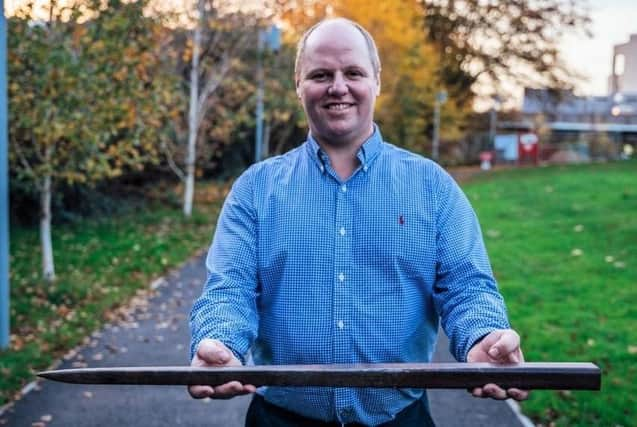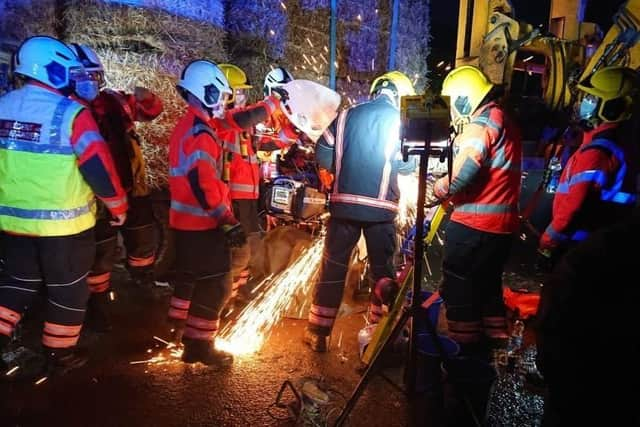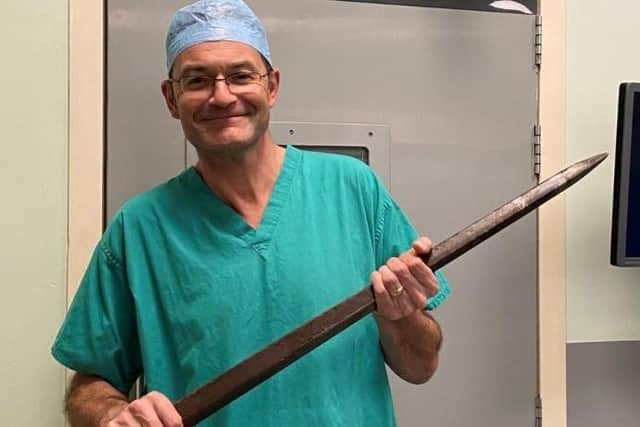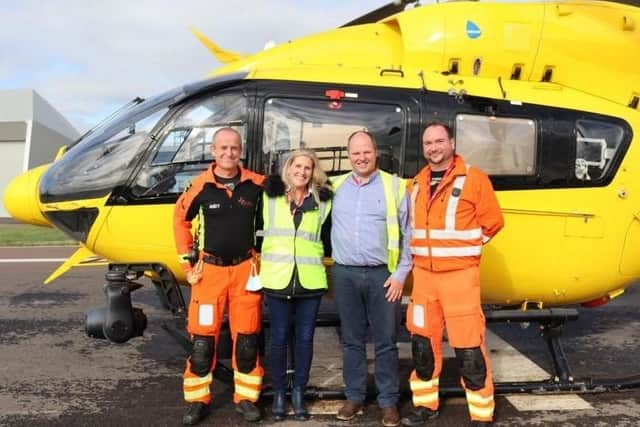WATCH: NI farmer impaled by tine thanks emergency teams who saved his life


Jonathan Willis, who now lives near Wisbech in England, was unloading straw bales in October 2020 when the accident occurred at Redgate Farm.
The 42-year-old had jumped out of the loader he was driving to pull a strap off a trailer when the machine rolled forward and the tine pierced through his lower back, exiting through his abdomen.
Advertisement
Advertisement
Jonathan explained: “It was a normal Monday afternoon, I was doing the jobs I always do.
“I was loading straw from one trailer onto another lorry.
“So, I brought the loader round. The two lads that were with me were at the far side of the trailer taking the lorry straps off.
“But, being a bit impatient that I was, I got out of the loader and started to pull the strap down to speed the job up.
“At that stage, the loader rolled forward and I felt a prod in my back and I turned round slightly to see what it was and the spike basically went straight through.”


Advertisement
Advertisement
His wife, Wendy, added: “When I realised Jonathan was injured, I was in the office.
“I could hear him shout and it sounded quite serious so I ran directly out to him.”
Wendy rang 999 and emergency services, including the East Anglian Air Ambulance (EAAA), rushed to the scene.
“When I first realised the air ambulance was there, I looked up and my initial reaction was, ‘thank you God, thank you for sending your angels’,” Wendy said.


Advertisement
Advertisement
“Whilst Jonathan was being treated, it was chaotic, there was fire engines, there was the air ambulance, there was ambulances, there was police, there was a lot of lights, there was a lot of people.
“It was chaotic and it was surreal and, to be honest, you do often think about how people feel during accidents and what it’s like for them and, all I can say is, it’s like living your worst nightmare.
“The fire brigade were instrumental, without a shadow of a doubt, they got the lights up, they had a frame on the machinery and they were there to cut the spike off so Jonathan could then be released.”
During the rescue operation, the 42-year-old father of five kept thinking ‘I need to be strong for Wendy and the girls, I have to get better’.


Advertisement
Advertisement
He added: “[I was thinking] this can’t be the end, you know, and I was just so grateful to have such knowledgeable people there that knew what they were doing.
“Had it not been for the air ambulance team, I think the whole situation could have been totally different.
“What happened to me was such an unusual accident. I’m just so grateful to all the teams involved.
“Thank you to the air ambulance, the ambulance, the fire brigade, the police, the surgeons and all their teams, the nurses and all the aftercare – just thank you so much.”
Advertisement
Advertisement
Wendy said the family were aware of the air ambulance, but admitted it’s in that second that you need them, ‘that they’re there saving your loved one’s life’, that you really appreciate the importance of them.
She continued: “For us as a family, our lives could have been dramatically changed on the 26 October.
“The girls could have lost their daddy and I could have lost my husband and, when you’re faced with that, your world is literally falling around you.”
The tine had entered through Jonathan’s lower back and exited through his abdomen, posing severe risk to several major internal organs and blood vessels, making it a time-critical and life-threatening situation.
Advertisement
Advertisement
He was cut free around 45 minutes after the EAAA team arrived at the scene, but the length, weight and position of the tine – still in place – meant that Jonathan could not be safely transferred in the helicopter.
EAAA Doctors, James Hale and Nathan Howes, and Critical Care Paramedic, Andy Bates, travelled with Jonathan in the ground ambulance for just over an hour to get him safely to Addenbrooke’s Hospital.
EAAA Consultant, Dr. Nathan Howes, said: “I have worked for East Anglian Air Ambulance since 2015, and frequently attend incidents involving trapped patients, but I had never been to an incident quite like this, or met a patient quite like Jonathan.
“It was incredibly important that any movement of Jonathan or the tine was minimised, in case it worsened any internal bleeding, but we also needed to free him quickly.
Advertisement
Advertisement
“The advanced pain relief that we carry was still a risk to Jonathan’s tiring legs, having held the same position for an hour.
“I was so impressed by how stoic Jonathan and his wife, Wendy, were.
“This definitely helped while we devised a plan with the fire and rescue and ambulance services to support Jonathan, cut the tine and release him safely.
“Fortunately, the careful release and Jonathan’s vital signs meant that we could take him directly to my colleagues at Cambridge Major Trauma Centre.
Advertisement
Advertisement
“And, I’ll never forget the sense of humour he maintained until we reached the operating theatre.
“It felt like treating a friend. I have been amazed by his survival and recovery, and I am so grateful to Jonathan and Wendy for visiting us, a year later.
“These stories sustain us and help keep us ready for the next call.”
Led by expert surgeon, Mr Emmanuel Huguet, the surgical teams worked throughout the night to save Jonathan, operating on him for almost seven hours.
Advertisement
Advertisement
Miraculously, the thick steel tine was safely removed, despite being just millimetres from causing life-threatening internal bleeding and damaging vital organs.
Consultant Liver and Transplant Surgeon at Addenbrooke’s Hospital, Mr Huguet, recalled his experience leading the complex surgery to save Jonathan’s life.
He commented: “Upon hearing the description on Mr Willis’ injuries, I was completely taken aback and had to ask for the information to be repeated three times.
“It seemed near impossible for someone to have survived such injuries as that area of the abdomen is full of overlapping, tightly-packed-together, organs and very major blood vessels.
Advertisement
Advertisement
“In order to carry out this highly complex surgery, there were approximately 30 people in the operating theatre at one point, including colleagues who held the spike in place from underneath before we were sure it was safe to remove.
“When we finally had everything in place to safely open Mr Willis’ abdomen, we were astounded by the trajectory of the spike.
“It had transfixed parts of the intestine, but somehow found an incredibly improbable ‘eye of the needle’ line past all the major blood vessels, as well as missing the right kidney, liver, and pancreas. At that point it was possible to safely remove the spike and repair the intestinal injuries.
“Mr Willis was simultaneously very unfortunate to have his injury, and also miraculously lucky that the spike didn’t cause any life-threatening damage to the numerous large blood vessels in its path.
Advertisement
Advertisement
“To this day, on CT scans, I cannot draw a straight line between the entry and exit points without going through vital structures. The spike must have pushed those vessels out of the way as it advanced.
“Mr Willis’ incredible recovery is down to his amazing composure and courage throughout this ordeal and the amazing team work I witnessed that night at Addenbrooke’s.
“Many people from different professions in the emergency services - in and out of the hospital - drew on years of experience and know-how to get Mr Willis safely recovered.
“I found the efficient, focussed, professional performance of everyone involved very moving, as well as the fact that everything was done with gentleness and care in spite of the technicality and urgency of the situation.”
Advertisement
Advertisement
One year on from the accident, the Willis family have raised over £45,000 at a charity ball in aid of the EAAA, to thank them for the part they played in Jonathan’s rescue and to help keep the charity in the air for those who need it.
Wendy stated: “We know that without the enhanced skills of the air ambulance team that day Jonathan wouldn’t have made it to hospital.
“They took control of the situation – which was like living my worst nightmare – and made all the right decisions which got him to the right hospital, and to the right surgeon, with a fighting chance.
“We were then so incredibly lucky that Jonathan had one of the best surgeons in the country leading his operation.
“The Addenbrooke’s team quite literally worked miracles in the operating theatre that night and ensured that Jonathan came home to me and our five children in one piece,” she ended.